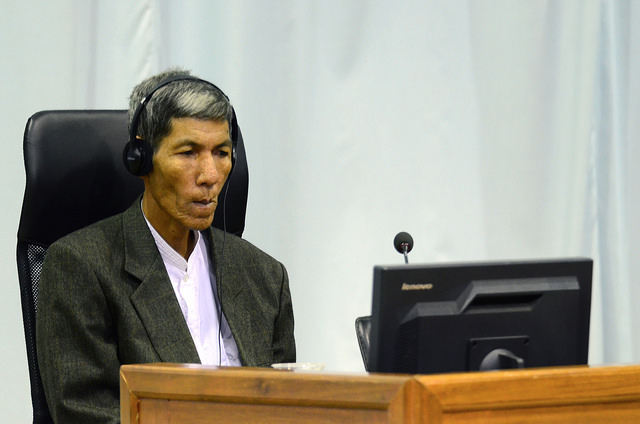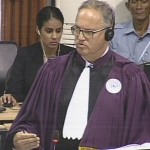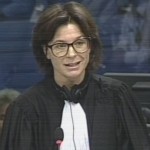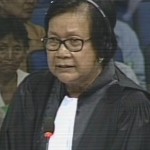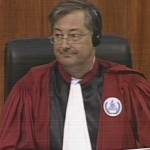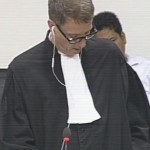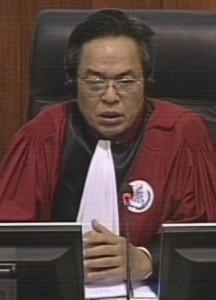“You ask me again and again . . . Mr. President please help me” – Former Commander of Unit Ka 4 Testifies
The examination of Mr. Keo Loeur, third witness to the Kampong Chhnang airport (which had begun on Friday) continued today.
The first session of the the day (and last allotted session for the prosecution and civil parties) was divided between Mr. William Smith Deputy Co-Prosecutor, Ms. Marie Guiraud International Civil Party Lead Co-Lawyer, and Ms. Chet Vanly Civil Party Co-Lawyer.
Judge Lavergne used the second session of the day to clarify many points.
Victor Koppe, defense counsel for Nuon Chea, cross-examined the witness Mr. Loeur for the afternoon.
The alleged crimes committed by the defendants at the Kampong Chhnang airport, which is the subject of this part of trial 002/02, are detailed here.
The OCIJ interview of this witness is available online, here.
—
Torture at Calmette Hospital
Mr. William Smith Deputy Co-Prosecutor continued his questioning from the prior Friday by asking about torture near Calmette Hospital in 1975.
The witness said that one time he saw a person being tied and hanged on the branch of a tree by Khmer Rouge soldiers.
The witness said he additionally saw 30 more people being tortured. When asked why he thought they had been tortured, Mr. Loeur said: “from what I heard [at the time] they were accused of being in the enemy network.”
Khmer Rouge troops were the ones who were being tortured, according to Mr. Loeur; some of them were soldiers in Division 310, some of them were former soldiers in the Lon Nol Regime.
Taped Confessions
Mr. Loeur explained that once Ta Ouen (the head of Division 310) was arrested there was a meeting called. At that meeting a tape of Ta Oeun and Ta Kim’s confessions was played. The recording, according to Mr. Loeur, was a description of Ta Oeun and Ta Kim activities from the beginning of the revolution until they betrayed the revolution.
Mr. Loeur said that from what he knew himself they had confessed to the traitorous activities. He said he also know that Ta Oeun and Ta Kim were about to overthrow the Khmer Rouge regime because he saw weapons being transported and was asked to pack food.
Mr. Loeur, though, explains, over the objection of Mr. Kong Sam Onn, Co-Lawyer for Khieu Samphan, that the plan was never executed because main people involved in the attempt were arrested.
Mr. Loeur confirmed that there was no attempt to resist or fight back during any of these arrests and that he never heard of anyone receiving a public trial to challenge any accusation made against them.
Nuon Chea at the Kampong Chhnang Airfield
Although Mr. Loeur’s statement to the OCIJ says that he recognized Nuon Chea when he visited the Kampong Chhnang Airfield, because he had seen him lead education sessions at the Olympic stadium in Phnom Penh, he told the court that he no longer remembers.
When Mr. Smith read him his own statement from the OCIJ where he had stated that he had recognized Ieng Sary, Nuon Chea and Ke Pauk at the airfield, Mr Loeur said: “I may have forgotten it because it happened a long time ago.”
__
Civil Parties
Ms. Marie Guiraud, International Civil Party Lead Co-Lawyer, took the floor and confirmed that he arrived on the 15th of January of 1978, per his testimony on Friday, to the Kampong Chhnang Airfield.
Mr. Loeur also confirmed what he had told DC-Cam that at the airfield “there was a very large number of people from many units. They came in thousands, all adults without exception.”
Mr. Loeur then explained that hundreds of people attended the meetings. He said that he was told that the reason he was at the Kampong Chhnang Airfield was for “tempering.”
At the meetings, Mr. Loeur said they were told that “all comrades were former soldiers that were affiliated with the former regime and we needed to be tempered from this time onward . . . we could not make any complaint . . .we were told to bear the situation . . we were told that if anyone did not work hard we would be arrested and tortured. . . I used to see people being taken away at those meetings. I never saw them back after their arrest.”
The resting place where he slept, Mr. Loeur said, was about 1 kilometer from the worksite. He said the sleeping quarters were small houses made out of leaves. There were 15 people in each house and none of them had any blankets.
Medical treatment was available for the workers who fell ill
“When my work colleagues felt seriously sick, Mr. Loeur said, “a truck would come and pick them up and send them to the city. . .they would be back in a couple of days.“
—
Ms. Guiraud then ceded the floor to her colleague, Ms. Chet Vanly, Civil Party Co-Lawyer.
Ms. Vanly confirmed that Ta Lvey was in charge of the airfield as well as Ta Met, per Mr. Loeur’s testimony. Mr. Loeur explained that Ta Met visited once a week. During his visit, he was always in a jeep with two to three bodyguards. “I did not even dare to look at his face,” Mr. Loeur said.
Mr. Loeur explained that they ate in companies and the food ration was given by companies. He said that there was soup and that they were given a bowl of rice but it was not sufficient.
“The food was not enough,” Mr. Loeur said, “we did hard work and the food given to us was little.”
Mr. Loeur also confirmed that his instructor in Phnom Penh that had taught him how to survey land and compress it enough (90% compressed minimum—he said) was a Chinese man assisted by an interpreter.
__
Questions from the Bench
Judge Lavergne was given the floor by the President after the prosecution and civil party lawyers had finished.
Mr. Loeur explained to the judge that the runway at Kampong Chhnang was 1,800 meters long and 50 meters wide. Mr. Loeur also confirmed to the chamber that caves in the mountains were dug to hide military planes.
Judge Lavergne then asked if he had joined the revolution willingly when he had just turned 18 years old in 1970.
“I was not a voluntary solider at that time. I was forced to join the army. . . My father was called to attend a meeting and my father was told that if he did not allow the children to go to the battlefield, the parents would be mistreated.”
At the indoctrination meetings that Mr. Loeur attended, “We were indoctrinated to take revenge against the feudalists, capitalists, and reactionaries and liberate the poor class . . . We were indoctrinated that we had to eliminate the capitalist reactionary classes in Cambodia.”
Mr. Loeur then explained that at the indoctrination meeting he was also told to “get angry with other religions.”
They were told, he said, that religion was a class that needed to be suppressed and that they mentioned that he had been a petit bourgeois because he had been a monk.
Mr. Loeur then explained that between 1970 and 1973 nothing happened to the monks or the pagodas. Between 1973 and 1975, he said, the monks were instructed to work in the fields and build bridges. All monks were defrocked in 1975, according to Mr. Loeur but he did not witness this. He was told this by his colleagues who later joined him in the battlefield.
Mr. Loeur said he did witnessed the demolition of the Christian church when he was a soldier. He did not see any Pagodas being destroyed.
Judge Lavergne then engaged the witness in a long line of questioning about the tapes that had been played at a meeting where Mr. Loeur had heard the voice of Ta Oeun and Ta Kim confess to betraying the revolution by allegedly organizing a coup. Judge Lavergne said he would not go into the substance of these confessions as the Chamber will rule on that later—as they may have been tainted by torture (see a summary of oral arguments on this matter by yours truly here) but he wanted to understand Mr. Loeur’s testimony.
Judge Lavergne summarized his testimony in the following way, to which Mr. Loeur agreed.
“So if summarize, you attended a meeting that was chaired by Ta Oeun, with the entire division, that took place in Phnom Pen in which he said that you should be better treated, receive wages and visit your families. He said that it was necessary to overthrow the regime and that there were weapons that had arrived in Phnom Penh… Then following this meeting, one day after, they were arrested. And two days after their arrest there was a reeducation meting where the sound of their confessions was broadcast.”
Mr. Loeur said: “Yes. That is correct.”
—
Defense for Nuon Chea
Victor Koppe, Defense Counsel for Nuon Chea, cross-examined the witness for the entire afternoon.
The first part of the cross-examination was geared towards ascertaining Mr. Loeur’s rank within division 310. There was no clarity as to whether Mr. Loeur had been the deputy chairman of a battalion or regiment or platoon at the same time that he had been chairman of Unit Ka 4.
Mr. Loeur insisted that there was no regiment/battalion (he said that a battalion usually had 500 soldiers) in Unit Ka 4. He said that Unit Ka 4 reported directly to the head of the division.
Mr. Loeur did confirm that he was chairman of Unit Ka 4 where he commanded 288 combatants and one young boy. Mr. Loeur also confirmed that he was appointed chairman one week after the arrest of the prior commander Teu or Ti, which is noted, per Koppe’s reading of the documents, on the 4th of March of 1977.
Mr. Loeur said that he was chairman only for two weeks and then he was sent for tempering. He said he did asked why they had promoted him and then sent him form tempering and the response “was that I was affiliated with previous commanders who were accused of being enemies,” Mr. Loeur said.
Although Mr. Loeur said he was chairman of Ka 4 for only two weeks but then said that he was in the leadership level when Kung Vun alias Han was arrested on the 18th of April of 1977. Mr. Loeur denies though that it was his decision to have him arrested. He said that the South West Cadres gave him a list and they carried out the arrest.
“Although I was in the leadership level,” Mr. Loeur affirmed “I had no say in [who was arrested] as they said the North people were traitors, and it was them [the South West cadres] who had the list and who would call people to be arrested.”
Mr. Koppe then reads from a document which he calls the joint statistics of the Revolutionary Armed Forces of Kampuchea (RAK) from March or April of 1977. The document says that Division 310, where Mr. Loeur served, consisted of 6,096 members of which 1,127 were sent around March or April of that year to work at the Kampong Chhnang Airport. That means that 1 out 6 members of his Division were sent to work there, Koppe explains. Mr. Loeur, the witness, replies that he doesn’t know how many people went to work there.
Mr. Koppe then focuses on when he stopped being a soldier. Mr. Loeur says that his right to bear arms was removed in 1975 but then he said that it was after he became disabled or when he was sent for tempering that his right to bear arms was taken away. Mr. Koppe focuses on the fact that in October 1977 150 members of Unit Ka 4 were sent to fight the Vietnamese. The witness Mr. Loeur, confirms that of course they had weapons.
“Those soldiers who were sent to fight of course they did not go with their bare hands,” he says.
Mr. Koppe then pushes Mr. Loeur to compare the living situation when he was commander of Ka 4 and when he was working at the Kampong Chhnang airport.
Mr. Loeur confirms that similar to the airport he had no mosquito nets or sleeping mats when he was commander. He also confirms that he received nor gave any wages when he was commander or when he was at the Kampong Chhnang airport.
“Is it fair to say it [being a commanding officer] wasn’t that much different from the Kampong Chhnang airfield?”
“That is correct.” Mr. Loeur responded.
Mr. Koppe proceeds to ask Mr. Loeur to give the Chamber one difference between his work as commanding officer and his work at the Kampong Chhnang Airfield.
Mr. Smith objects and Mr. Koppe reveals the strategy behind his cross-examination: “It is our position, Mr. Koppe said, “that his unit wasn’t even tempered at all. . . But it is fair to compare [his work as commanding officer] with forced labor, as the closing order states occurred at the Kampong Chhnang Airport.” Mr. Koppe says he is trying to understand “which working conditions were a product of the natural working conditions of soldiers and which were a product of forced labor.”
Mr. Smith retracts his objection and says his initial objection was more of an observation.
Mr. Koppe continues and asks Mr. Loeur whether he was ever “re-fashioned” or “tempered” at all.
“Is it correct, Mr. Koppe asks, “that you were never re-fashioned? You were a loyal cadre for all 9 years.”
“This is a repetitive question,” Mr. Loeur answers, “You ask me again and again. It is very difficult for me to respond. … Mr. President please help me.”
The President then carefully explains the process of the court and how he’s being cross-examined and that he can say he doesn’t know if he doesn’t know.
Mr. Koppe asks again:
“Witness, is it true that you were a loyal cadre from 1970 to 1979 and in fact you were never tempered or refashioned?”
“From 1970 to 1975 I was a solider,” Mr. Loeur stands firm, “but later on in 1977 I was then refashioned and tempered.”

